BO1BLAW204 Business Law: Legal Analysis of Business Case Studies
VerifiedAdded on 2023/06/12
|8
|2358
|178
Report
AI Summary
This report provides a legal analysis of two distinct scenarios. The first scenario examines a contract between Angela and Jessica, focusing on whether Jessica misrepresented the restaurant's earnings, potentially invalidating the contract. It applies the law of misrepresentation, emphasizing factual representation, untruthfulness, intent to influence, and reliance by the plaintiff. The analysis concludes that Jessica's statements constitute misrepresentation, granting Angela the right to terminate the contract and seek damages. The second scenario advises the Smiths on their chances of suing Acme for negligence after Andy consumes a contaminated cola bottle. It applies the law of negligence, emphasizing duty of care, breach of duty, and causation. The analysis determines that Acme owed a duty of care, breached that duty, and caused Andy's illness, making them liable for his losses, but not Sandra's remote income loss.
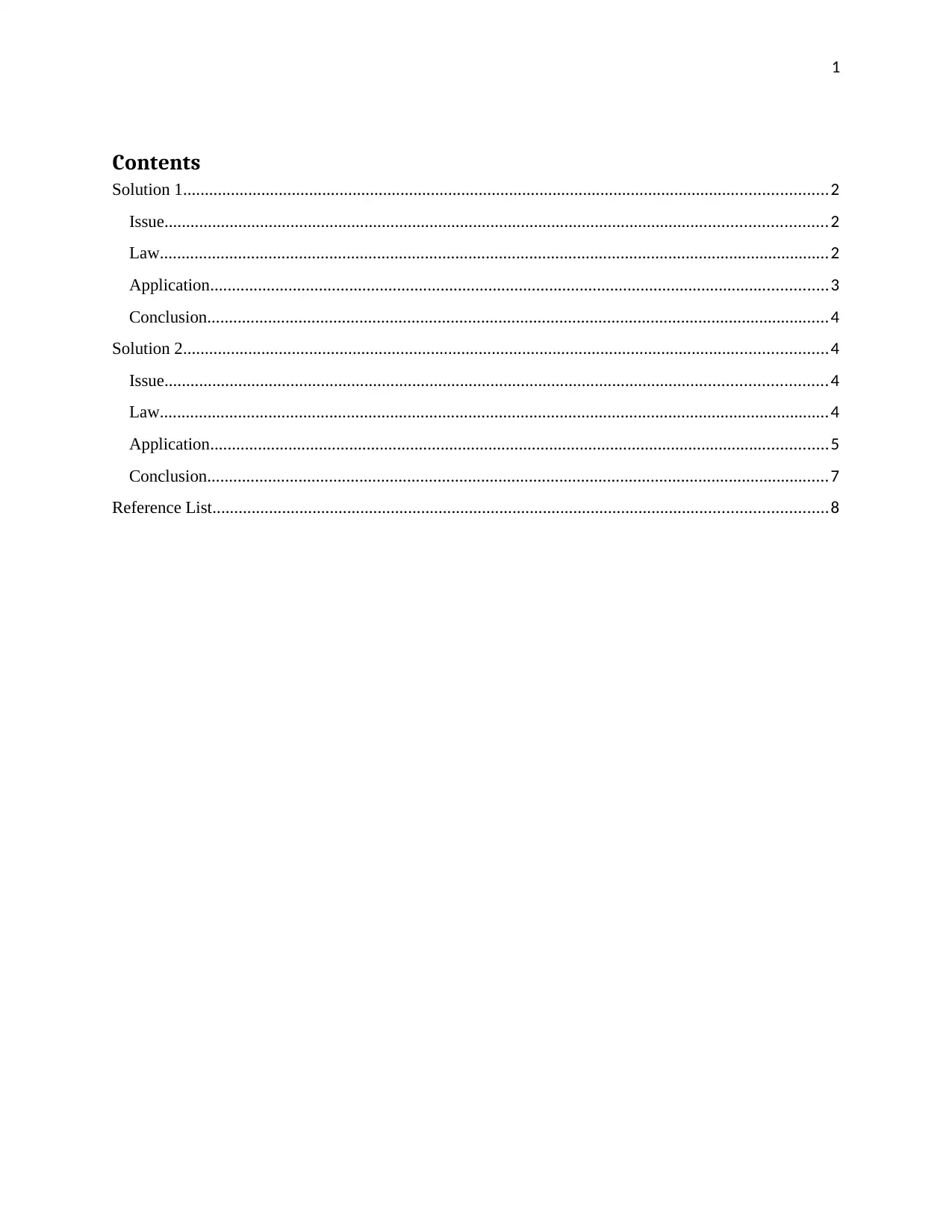
1
Contents
Solution 1....................................................................................................................................................2
Issue........................................................................................................................................................2
Law..........................................................................................................................................................2
Application..............................................................................................................................................3
Conclusion...............................................................................................................................................4
Solution 2....................................................................................................................................................4
Issue........................................................................................................................................................4
Law..........................................................................................................................................................4
Application..............................................................................................................................................5
Conclusion...............................................................................................................................................7
Reference List.............................................................................................................................................8
Contents
Solution 1....................................................................................................................................................2
Issue........................................................................................................................................................2
Law..........................................................................................................................................................2
Application..............................................................................................................................................3
Conclusion...............................................................................................................................................4
Solution 2....................................................................................................................................................4
Issue........................................................................................................................................................4
Law..........................................................................................................................................................4
Application..............................................................................................................................................5
Conclusion...............................................................................................................................................7
Reference List.............................................................................................................................................8
Paraphrase This Document
Need a fresh take? Get an instant paraphrase of this document with our AI Paraphraser
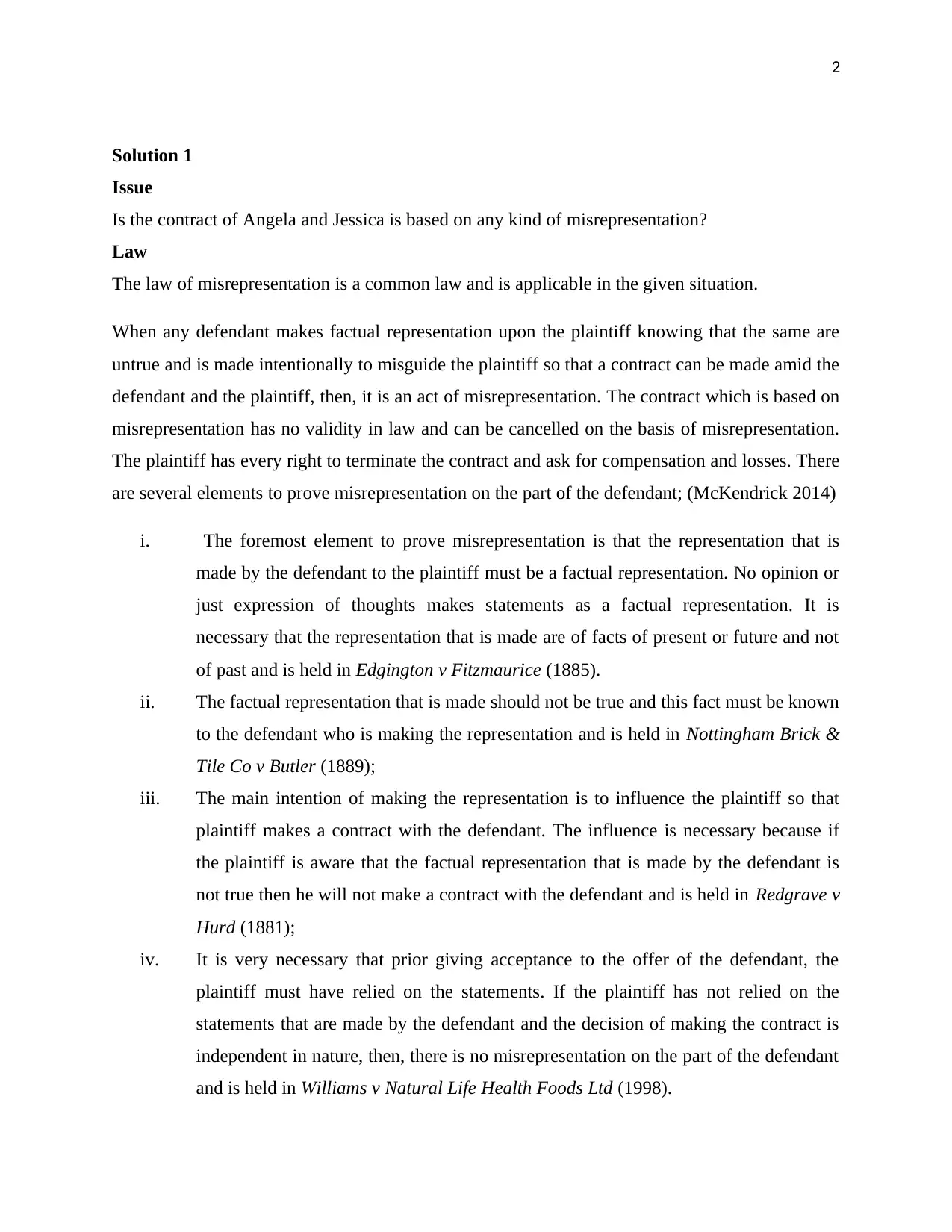
2
Solution 1
Issue
Is the contract of Angela and Jessica is based on any kind of misrepresentation?
Law
The law of misrepresentation is a common law and is applicable in the given situation.
When any defendant makes factual representation upon the plaintiff knowing that the same are
untrue and is made intentionally to misguide the plaintiff so that a contract can be made amid the
defendant and the plaintiff, then, it is an act of misrepresentation. The contract which is based on
misrepresentation has no validity in law and can be cancelled on the basis of misrepresentation.
The plaintiff has every right to terminate the contract and ask for compensation and losses. There
are several elements to prove misrepresentation on the part of the defendant; (McKendrick 2014)
i. The foremost element to prove misrepresentation is that the representation that is
made by the defendant to the plaintiff must be a factual representation. No opinion or
just expression of thoughts makes statements as a factual representation. It is
necessary that the representation that is made are of facts of present or future and not
of past and is held in Edgington v Fitzmaurice (1885).
ii. The factual representation that is made should not be true and this fact must be known
to the defendant who is making the representation and is held in Nottingham Brick &
Tile Co v Butler (1889);
iii. The main intention of making the representation is to influence the plaintiff so that
plaintiff makes a contract with the defendant. The influence is necessary because if
the plaintiff is aware that the factual representation that is made by the defendant is
not true then he will not make a contract with the defendant and is held in Redgrave v
Hurd (1881);
iv. It is very necessary that prior giving acceptance to the offer of the defendant, the
plaintiff must have relied on the statements. If the plaintiff has not relied on the
statements that are made by the defendant and the decision of making the contract is
independent in nature, then, there is no misrepresentation on the part of the defendant
and is held in Williams v Natural Life Health Foods Ltd (1998).
Solution 1
Issue
Is the contract of Angela and Jessica is based on any kind of misrepresentation?
Law
The law of misrepresentation is a common law and is applicable in the given situation.
When any defendant makes factual representation upon the plaintiff knowing that the same are
untrue and is made intentionally to misguide the plaintiff so that a contract can be made amid the
defendant and the plaintiff, then, it is an act of misrepresentation. The contract which is based on
misrepresentation has no validity in law and can be cancelled on the basis of misrepresentation.
The plaintiff has every right to terminate the contract and ask for compensation and losses. There
are several elements to prove misrepresentation on the part of the defendant; (McKendrick 2014)
i. The foremost element to prove misrepresentation is that the representation that is
made by the defendant to the plaintiff must be a factual representation. No opinion or
just expression of thoughts makes statements as a factual representation. It is
necessary that the representation that is made are of facts of present or future and not
of past and is held in Edgington v Fitzmaurice (1885).
ii. The factual representation that is made should not be true and this fact must be known
to the defendant who is making the representation and is held in Nottingham Brick &
Tile Co v Butler (1889);
iii. The main intention of making the representation is to influence the plaintiff so that
plaintiff makes a contract with the defendant. The influence is necessary because if
the plaintiff is aware that the factual representation that is made by the defendant is
not true then he will not make a contract with the defendant and is held in Redgrave v
Hurd (1881);
iv. It is very necessary that prior giving acceptance to the offer of the defendant, the
plaintiff must have relied on the statements. If the plaintiff has not relied on the
statements that are made by the defendant and the decision of making the contract is
independent in nature, then, there is no misrepresentation on the part of the defendant
and is held in Williams v Natural Life Health Foods Ltd (1998).
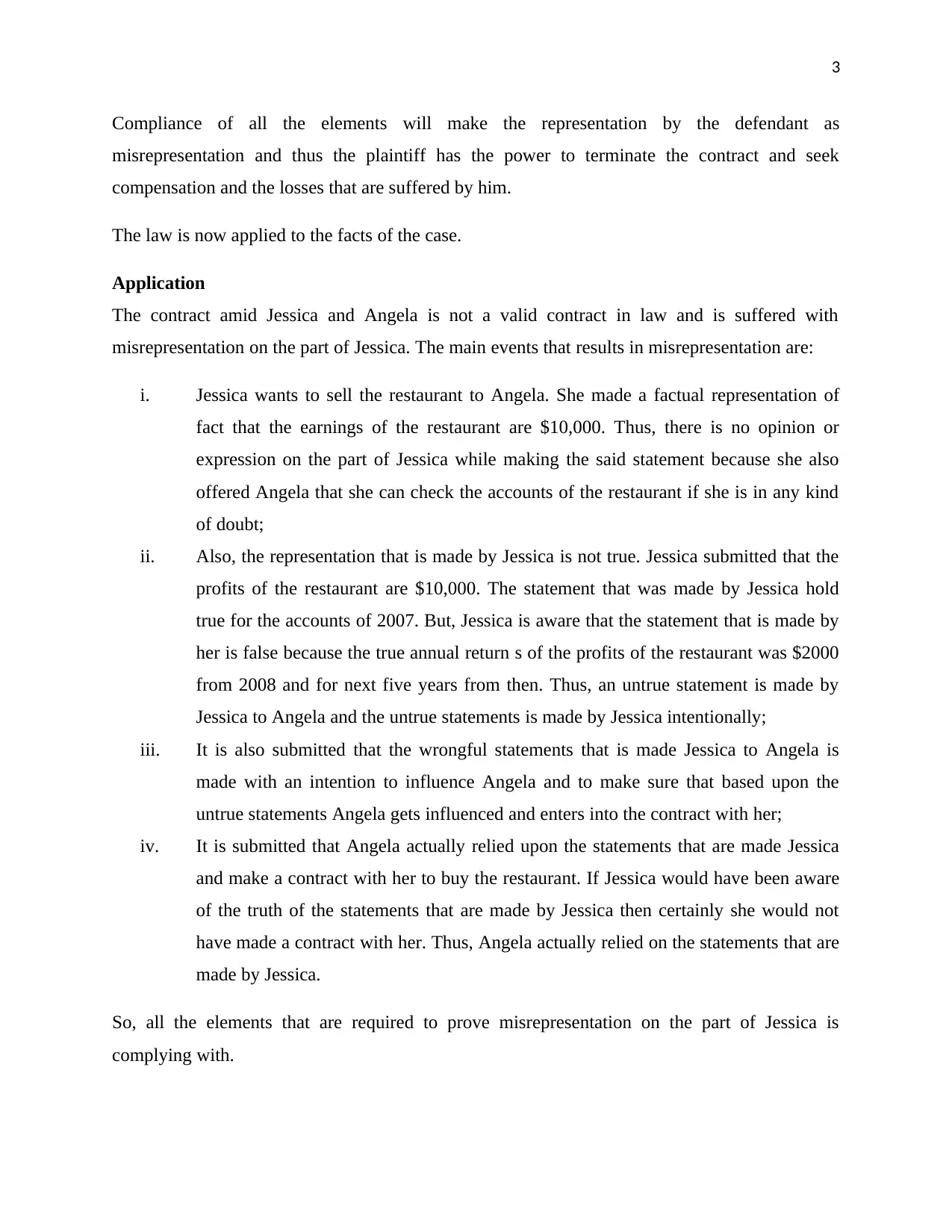
3
Compliance of all the elements will make the representation by the defendant as
misrepresentation and thus the plaintiff has the power to terminate the contract and seek
compensation and the losses that are suffered by him.
The law is now applied to the facts of the case.
Application
The contract amid Jessica and Angela is not a valid contract in law and is suffered with
misrepresentation on the part of Jessica. The main events that results in misrepresentation are:
i. Jessica wants to sell the restaurant to Angela. She made a factual representation of
fact that the earnings of the restaurant are $10,000. Thus, there is no opinion or
expression on the part of Jessica while making the said statement because she also
offered Angela that she can check the accounts of the restaurant if she is in any kind
of doubt;
ii. Also, the representation that is made by Jessica is not true. Jessica submitted that the
profits of the restaurant are $10,000. The statement that was made by Jessica hold
true for the accounts of 2007. But, Jessica is aware that the statement that is made by
her is false because the true annual return s of the profits of the restaurant was $2000
from 2008 and for next five years from then. Thus, an untrue statement is made by
Jessica to Angela and the untrue statements is made by Jessica intentionally;
iii. It is also submitted that the wrongful statements that is made Jessica to Angela is
made with an intention to influence Angela and to make sure that based upon the
untrue statements Angela gets influenced and enters into the contract with her;
iv. It is submitted that Angela actually relied upon the statements that are made Jessica
and make a contract with her to buy the restaurant. If Jessica would have been aware
of the truth of the statements that are made by Jessica then certainly she would not
have made a contract with her. Thus, Angela actually relied on the statements that are
made by Jessica.
So, all the elements that are required to prove misrepresentation on the part of Jessica is
complying with.
Compliance of all the elements will make the representation by the defendant as
misrepresentation and thus the plaintiff has the power to terminate the contract and seek
compensation and the losses that are suffered by him.
The law is now applied to the facts of the case.
Application
The contract amid Jessica and Angela is not a valid contract in law and is suffered with
misrepresentation on the part of Jessica. The main events that results in misrepresentation are:
i. Jessica wants to sell the restaurant to Angela. She made a factual representation of
fact that the earnings of the restaurant are $10,000. Thus, there is no opinion or
expression on the part of Jessica while making the said statement because she also
offered Angela that she can check the accounts of the restaurant if she is in any kind
of doubt;
ii. Also, the representation that is made by Jessica is not true. Jessica submitted that the
profits of the restaurant are $10,000. The statement that was made by Jessica hold
true for the accounts of 2007. But, Jessica is aware that the statement that is made by
her is false because the true annual return s of the profits of the restaurant was $2000
from 2008 and for next five years from then. Thus, an untrue statement is made by
Jessica to Angela and the untrue statements is made by Jessica intentionally;
iii. It is also submitted that the wrongful statements that is made Jessica to Angela is
made with an intention to influence Angela and to make sure that based upon the
untrue statements Angela gets influenced and enters into the contract with her;
iv. It is submitted that Angela actually relied upon the statements that are made Jessica
and make a contract with her to buy the restaurant. If Jessica would have been aware
of the truth of the statements that are made by Jessica then certainly she would not
have made a contract with her. Thus, Angela actually relied on the statements that are
made by Jessica.
So, all the elements that are required to prove misrepresentation on the part of Jessica is
complying with.
⊘ This is a preview!⊘
Do you want full access?
Subscribe today to unlock all pages.

Trusted by 1+ million students worldwide
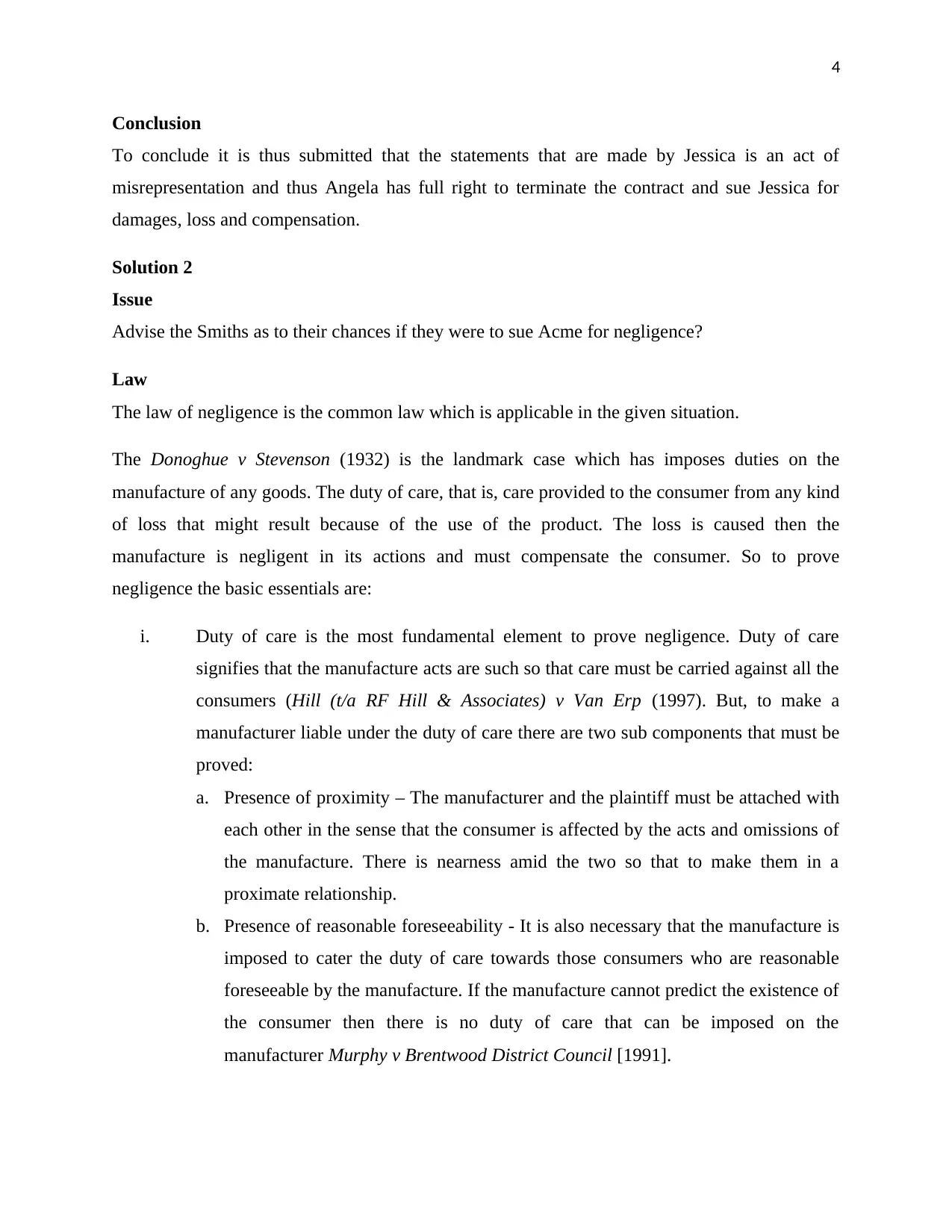
4
Conclusion
To conclude it is thus submitted that the statements that are made by Jessica is an act of
misrepresentation and thus Angela has full right to terminate the contract and sue Jessica for
damages, loss and compensation.
Solution 2
Issue
Advise the Smiths as to their chances if they were to sue Acme for negligence?
Law
The law of negligence is the common law which is applicable in the given situation.
The Donoghue v Stevenson (1932) is the landmark case which has imposes duties on the
manufacture of any goods. The duty of care, that is, care provided to the consumer from any kind
of loss that might result because of the use of the product. The loss is caused then the
manufacture is negligent in its actions and must compensate the consumer. So to prove
negligence the basic essentials are:
i. Duty of care is the most fundamental element to prove negligence. Duty of care
signifies that the manufacture acts are such so that care must be carried against all the
consumers (Hill (t/a RF Hill & Associates) v Van Erp (1997). But, to make a
manufacturer liable under the duty of care there are two sub components that must be
proved:
a. Presence of proximity – The manufacturer and the plaintiff must be attached with
each other in the sense that the consumer is affected by the acts and omissions of
the manufacture. There is nearness amid the two so that to make them in a
proximate relationship.
b. Presence of reasonable foreseeability - It is also necessary that the manufacture is
imposed to cater the duty of care towards those consumers who are reasonable
foreseeable by the manufacture. If the manufacture cannot predict the existence of
the consumer then there is no duty of care that can be imposed on the
manufacturer Murphy v Brentwood District Council [1991].
Conclusion
To conclude it is thus submitted that the statements that are made by Jessica is an act of
misrepresentation and thus Angela has full right to terminate the contract and sue Jessica for
damages, loss and compensation.
Solution 2
Issue
Advise the Smiths as to their chances if they were to sue Acme for negligence?
Law
The law of negligence is the common law which is applicable in the given situation.
The Donoghue v Stevenson (1932) is the landmark case which has imposes duties on the
manufacture of any goods. The duty of care, that is, care provided to the consumer from any kind
of loss that might result because of the use of the product. The loss is caused then the
manufacture is negligent in its actions and must compensate the consumer. So to prove
negligence the basic essentials are:
i. Duty of care is the most fundamental element to prove negligence. Duty of care
signifies that the manufacture acts are such so that care must be carried against all the
consumers (Hill (t/a RF Hill & Associates) v Van Erp (1997). But, to make a
manufacturer liable under the duty of care there are two sub components that must be
proved:
a. Presence of proximity – The manufacturer and the plaintiff must be attached with
each other in the sense that the consumer is affected by the acts and omissions of
the manufacture. There is nearness amid the two so that to make them in a
proximate relationship.
b. Presence of reasonable foreseeability - It is also necessary that the manufacture is
imposed to cater the duty of care towards those consumers who are reasonable
foreseeable by the manufacture. If the manufacture cannot predict the existence of
the consumer then there is no duty of care that can be imposed on the
manufacturer Murphy v Brentwood District Council [1991].
Paraphrase This Document
Need a fresh take? Get an instant paraphrase of this document with our AI Paraphraser
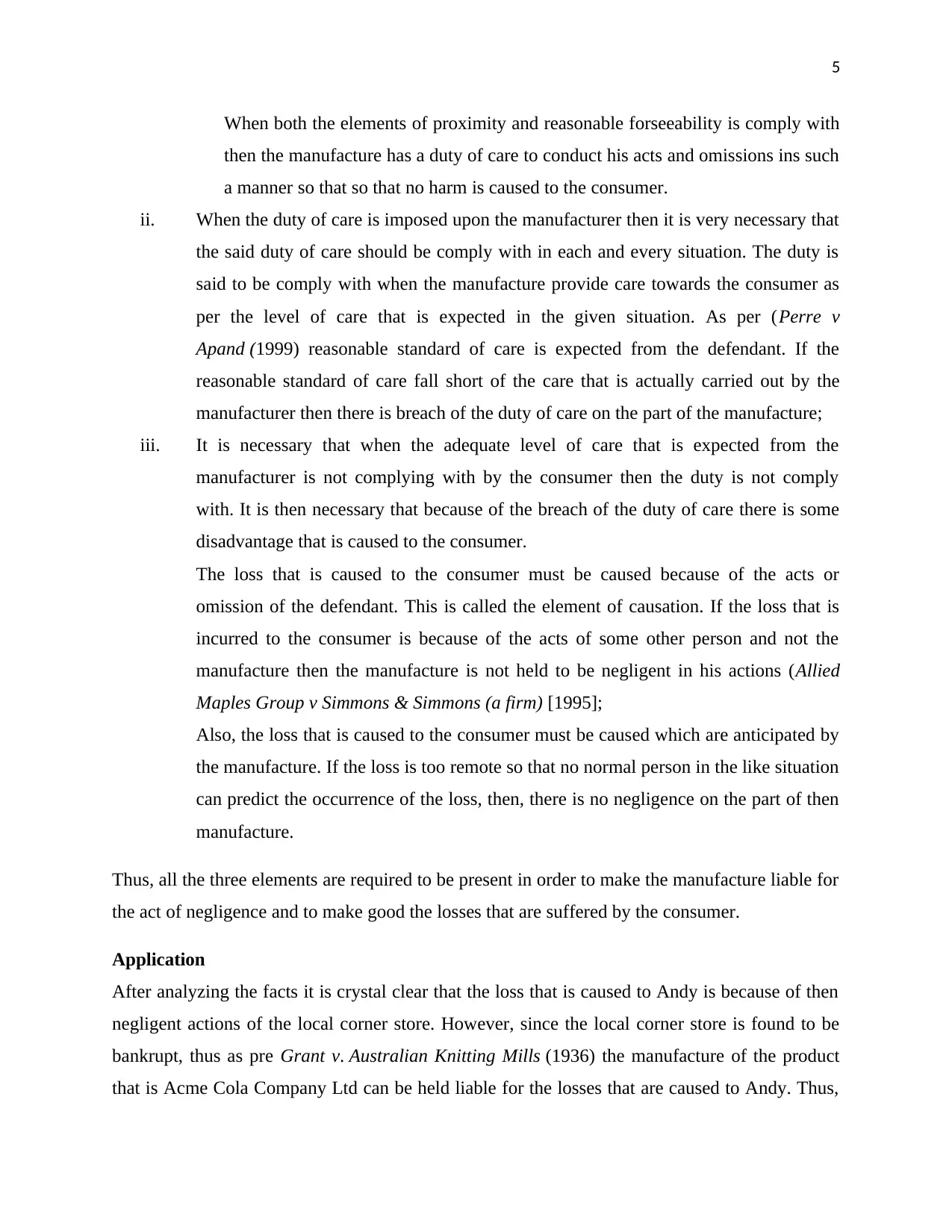
5
When both the elements of proximity and reasonable forseeability is comply with
then the manufacture has a duty of care to conduct his acts and omissions ins such
a manner so that so that no harm is caused to the consumer.
ii. When the duty of care is imposed upon the manufacturer then it is very necessary that
the said duty of care should be comply with in each and every situation. The duty is
said to be comply with when the manufacture provide care towards the consumer as
per the level of care that is expected in the given situation. As per (Perre v
Apand (1999) reasonable standard of care is expected from the defendant. If the
reasonable standard of care fall short of the care that is actually carried out by the
manufacturer then there is breach of the duty of care on the part of the manufacture;
iii. It is necessary that when the adequate level of care that is expected from the
manufacturer is not complying with by the consumer then the duty is not comply
with. It is then necessary that because of the breach of the duty of care there is some
disadvantage that is caused to the consumer.
The loss that is caused to the consumer must be caused because of the acts or
omission of the defendant. This is called the element of causation. If the loss that is
incurred to the consumer is because of the acts of some other person and not the
manufacture then the manufacture is not held to be negligent in his actions (Allied
Maples Group v Simmons & Simmons (a firm) [1995];
Also, the loss that is caused to the consumer must be caused which are anticipated by
the manufacture. If the loss is too remote so that no normal person in the like situation
can predict the occurrence of the loss, then, there is no negligence on the part of then
manufacture.
Thus, all the three elements are required to be present in order to make the manufacture liable for
the act of negligence and to make good the losses that are suffered by the consumer.
Application
After analyzing the facts it is crystal clear that the loss that is caused to Andy is because of then
negligent actions of the local corner store. However, since the local corner store is found to be
bankrupt, thus as pre Grant v. Australian Knitting Mills (1936) the manufacture of the product
that is Acme Cola Company Ltd can be held liable for the losses that are caused to Andy. Thus,
When both the elements of proximity and reasonable forseeability is comply with
then the manufacture has a duty of care to conduct his acts and omissions ins such
a manner so that so that no harm is caused to the consumer.
ii. When the duty of care is imposed upon the manufacturer then it is very necessary that
the said duty of care should be comply with in each and every situation. The duty is
said to be comply with when the manufacture provide care towards the consumer as
per the level of care that is expected in the given situation. As per (Perre v
Apand (1999) reasonable standard of care is expected from the defendant. If the
reasonable standard of care fall short of the care that is actually carried out by the
manufacturer then there is breach of the duty of care on the part of the manufacture;
iii. It is necessary that when the adequate level of care that is expected from the
manufacturer is not complying with by the consumer then the duty is not comply
with. It is then necessary that because of the breach of the duty of care there is some
disadvantage that is caused to the consumer.
The loss that is caused to the consumer must be caused because of the acts or
omission of the defendant. This is called the element of causation. If the loss that is
incurred to the consumer is because of the acts of some other person and not the
manufacture then the manufacture is not held to be negligent in his actions (Allied
Maples Group v Simmons & Simmons (a firm) [1995];
Also, the loss that is caused to the consumer must be caused which are anticipated by
the manufacture. If the loss is too remote so that no normal person in the like situation
can predict the occurrence of the loss, then, there is no negligence on the part of then
manufacture.
Thus, all the three elements are required to be present in order to make the manufacture liable for
the act of negligence and to make good the losses that are suffered by the consumer.
Application
After analyzing the facts it is crystal clear that the loss that is caused to Andy is because of then
negligent actions of the local corner store. However, since the local corner store is found to be
bankrupt, thus as pre Grant v. Australian Knitting Mills (1936) the manufacture of the product
that is Acme Cola Company Ltd can be held liable for the losses that are caused to Andy. Thus,
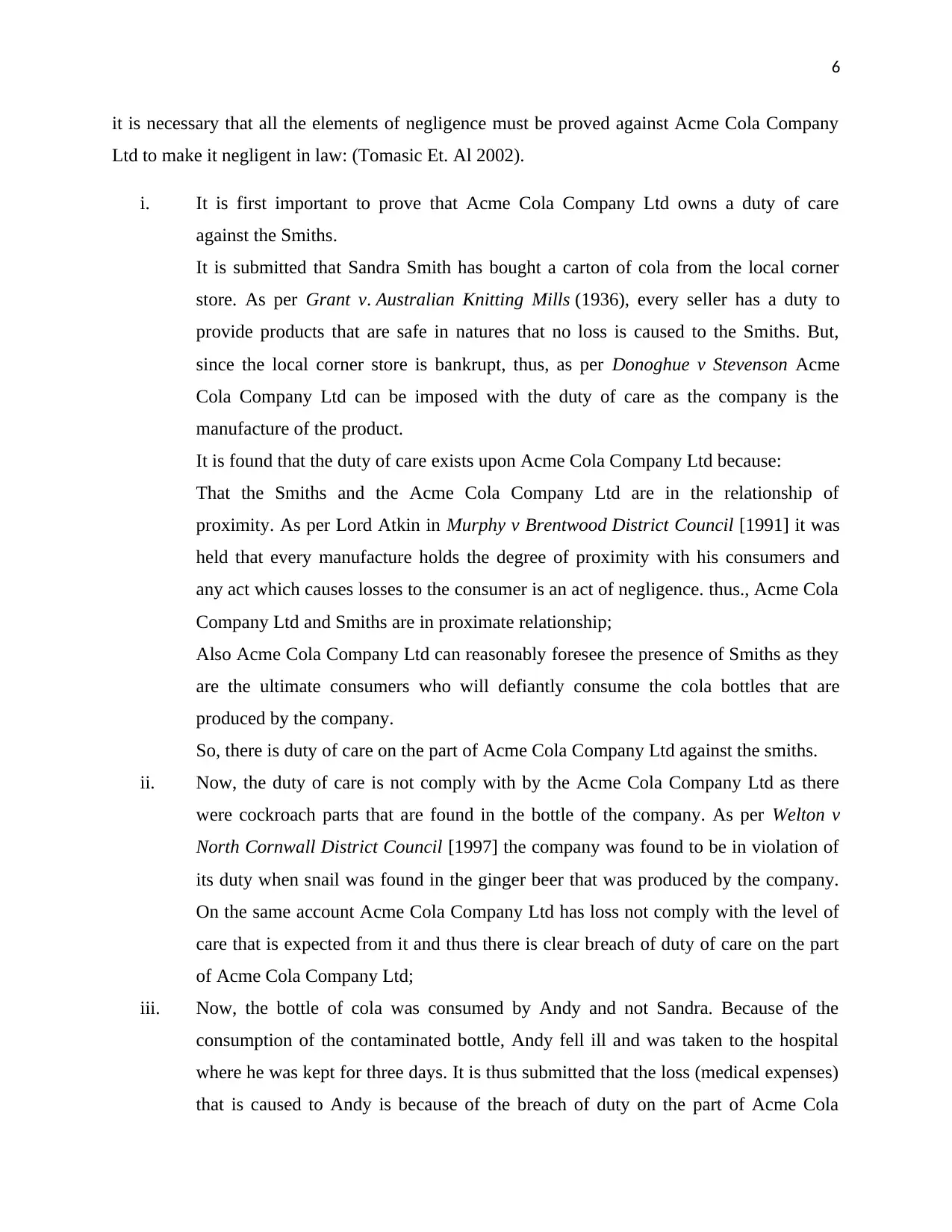
6
it is necessary that all the elements of negligence must be proved against Acme Cola Company
Ltd to make it negligent in law: (Tomasic Et. Al 2002).
i. It is first important to prove that Acme Cola Company Ltd owns a duty of care
against the Smiths.
It is submitted that Sandra Smith has bought a carton of cola from the local corner
store. As per Grant v. Australian Knitting Mills (1936), every seller has a duty to
provide products that are safe in natures that no loss is caused to the Smiths. But,
since the local corner store is bankrupt, thus, as per Donoghue v Stevenson Acme
Cola Company Ltd can be imposed with the duty of care as the company is the
manufacture of the product.
It is found that the duty of care exists upon Acme Cola Company Ltd because:
That the Smiths and the Acme Cola Company Ltd are in the relationship of
proximity. As per Lord Atkin in Murphy v Brentwood District Council [1991] it was
held that every manufacture holds the degree of proximity with his consumers and
any act which causes losses to the consumer is an act of negligence. thus., Acme Cola
Company Ltd and Smiths are in proximate relationship;
Also Acme Cola Company Ltd can reasonably foresee the presence of Smiths as they
are the ultimate consumers who will defiantly consume the cola bottles that are
produced by the company.
So, there is duty of care on the part of Acme Cola Company Ltd against the smiths.
ii. Now, the duty of care is not comply with by the Acme Cola Company Ltd as there
were cockroach parts that are found in the bottle of the company. As per Welton v
North Cornwall District Council [1997] the company was found to be in violation of
its duty when snail was found in the ginger beer that was produced by the company.
On the same account Acme Cola Company Ltd has loss not comply with the level of
care that is expected from it and thus there is clear breach of duty of care on the part
of Acme Cola Company Ltd;
iii. Now, the bottle of cola was consumed by Andy and not Sandra. Because of the
consumption of the contaminated bottle, Andy fell ill and was taken to the hospital
where he was kept for three days. It is thus submitted that the loss (medical expenses)
that is caused to Andy is because of the breach of duty on the part of Acme Cola
it is necessary that all the elements of negligence must be proved against Acme Cola Company
Ltd to make it negligent in law: (Tomasic Et. Al 2002).
i. It is first important to prove that Acme Cola Company Ltd owns a duty of care
against the Smiths.
It is submitted that Sandra Smith has bought a carton of cola from the local corner
store. As per Grant v. Australian Knitting Mills (1936), every seller has a duty to
provide products that are safe in natures that no loss is caused to the Smiths. But,
since the local corner store is bankrupt, thus, as per Donoghue v Stevenson Acme
Cola Company Ltd can be imposed with the duty of care as the company is the
manufacture of the product.
It is found that the duty of care exists upon Acme Cola Company Ltd because:
That the Smiths and the Acme Cola Company Ltd are in the relationship of
proximity. As per Lord Atkin in Murphy v Brentwood District Council [1991] it was
held that every manufacture holds the degree of proximity with his consumers and
any act which causes losses to the consumer is an act of negligence. thus., Acme Cola
Company Ltd and Smiths are in proximate relationship;
Also Acme Cola Company Ltd can reasonably foresee the presence of Smiths as they
are the ultimate consumers who will defiantly consume the cola bottles that are
produced by the company.
So, there is duty of care on the part of Acme Cola Company Ltd against the smiths.
ii. Now, the duty of care is not comply with by the Acme Cola Company Ltd as there
were cockroach parts that are found in the bottle of the company. As per Welton v
North Cornwall District Council [1997] the company was found to be in violation of
its duty when snail was found in the ginger beer that was produced by the company.
On the same account Acme Cola Company Ltd has loss not comply with the level of
care that is expected from it and thus there is clear breach of duty of care on the part
of Acme Cola Company Ltd;
iii. Now, the bottle of cola was consumed by Andy and not Sandra. Because of the
consumption of the contaminated bottle, Andy fell ill and was taken to the hospital
where he was kept for three days. It is thus submitted that the loss (medical expenses)
that is caused to Andy is because of the breach of duty on the part of Acme Cola
⊘ This is a preview!⊘
Do you want full access?
Subscribe today to unlock all pages.

Trusted by 1+ million students worldwide
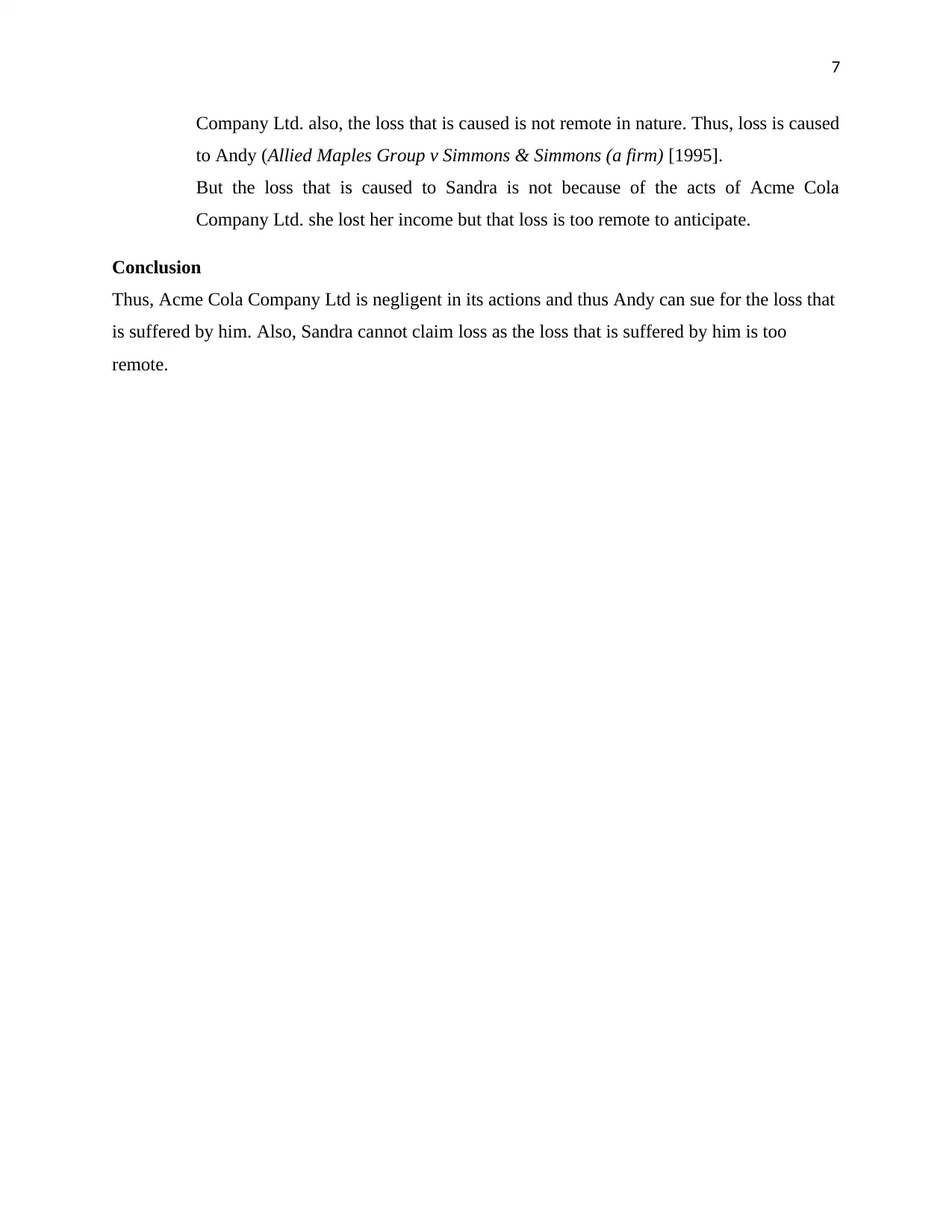
7
Company Ltd. also, the loss that is caused is not remote in nature. Thus, loss is caused
to Andy (Allied Maples Group v Simmons & Simmons (a firm) [1995].
But the loss that is caused to Sandra is not because of the acts of Acme Cola
Company Ltd. she lost her income but that loss is too remote to anticipate.
Conclusion
Thus, Acme Cola Company Ltd is negligent in its actions and thus Andy can sue for the loss that
is suffered by him. Also, Sandra cannot claim loss as the loss that is suffered by him is too
remote.
Company Ltd. also, the loss that is caused is not remote in nature. Thus, loss is caused
to Andy (Allied Maples Group v Simmons & Simmons (a firm) [1995].
But the loss that is caused to Sandra is not because of the acts of Acme Cola
Company Ltd. she lost her income but that loss is too remote to anticipate.
Conclusion
Thus, Acme Cola Company Ltd is negligent in its actions and thus Andy can sue for the loss that
is suffered by him. Also, Sandra cannot claim loss as the loss that is suffered by him is too
remote.
Paraphrase This Document
Need a fresh take? Get an instant paraphrase of this document with our AI Paraphraser
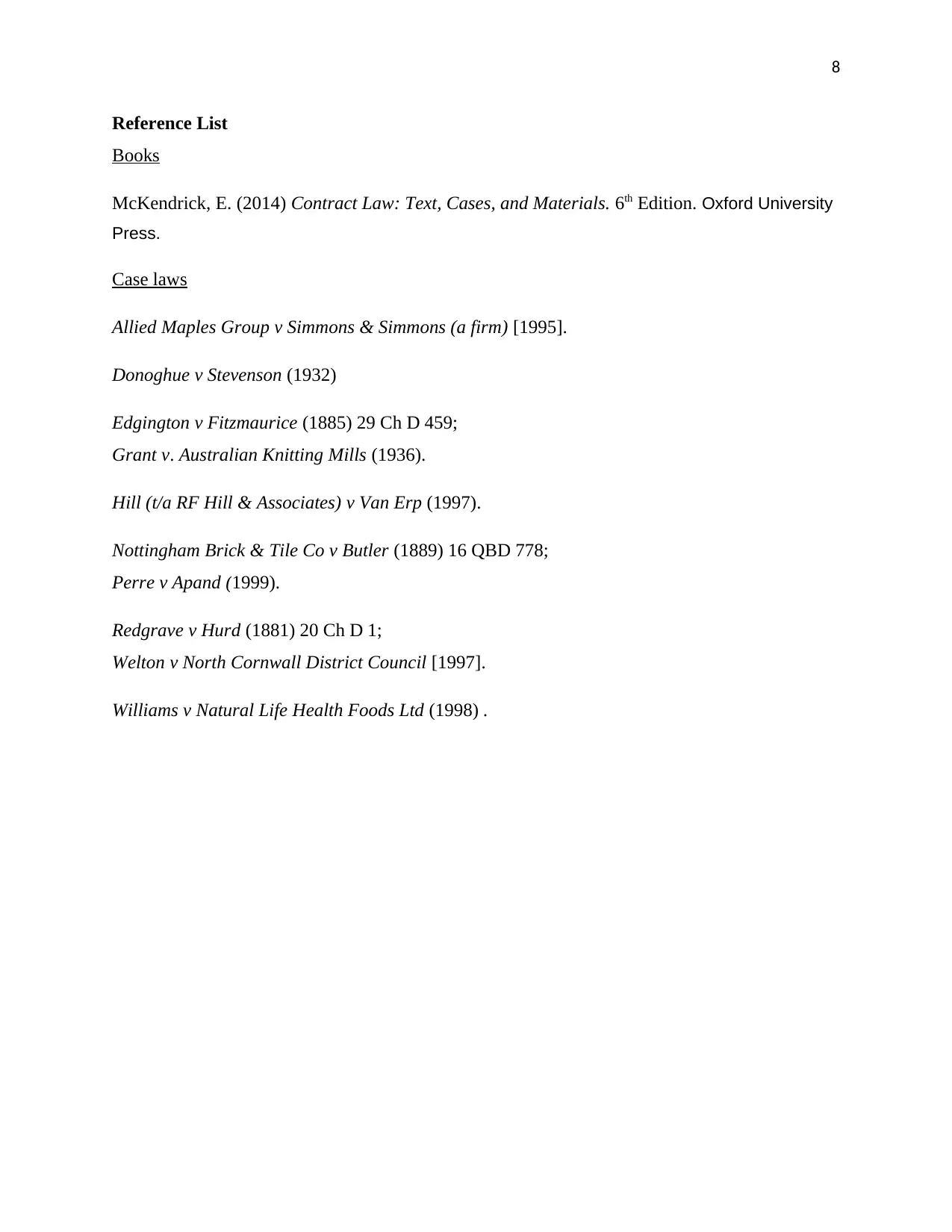
8
Reference List
Books
McKendrick, E. (2014) Contract Law: Text, Cases, and Materials. 6th Edition. Oxford University
Press.
Case laws
Allied Maples Group v Simmons & Simmons (a firm) [1995].
Donoghue v Stevenson (1932)
Edgington v Fitzmaurice (1885) 29 Ch D 459;
Grant v. Australian Knitting Mills (1936).
Hill (t/a RF Hill & Associates) v Van Erp (1997).
Nottingham Brick & Tile Co v Butler (1889) 16 QBD 778;
Perre v Apand (1999).
Redgrave v Hurd (1881) 20 Ch D 1;
Welton v North Cornwall District Council [1997].
Williams v Natural Life Health Foods Ltd (1998) .
Reference List
Books
McKendrick, E. (2014) Contract Law: Text, Cases, and Materials. 6th Edition. Oxford University
Press.
Case laws
Allied Maples Group v Simmons & Simmons (a firm) [1995].
Donoghue v Stevenson (1932)
Edgington v Fitzmaurice (1885) 29 Ch D 459;
Grant v. Australian Knitting Mills (1936).
Hill (t/a RF Hill & Associates) v Van Erp (1997).
Nottingham Brick & Tile Co v Butler (1889) 16 QBD 778;
Perre v Apand (1999).
Redgrave v Hurd (1881) 20 Ch D 1;
Welton v North Cornwall District Council [1997].
Williams v Natural Life Health Foods Ltd (1998) .
1 out of 8
Related Documents
Your All-in-One AI-Powered Toolkit for Academic Success.
+13062052269
info@desklib.com
Available 24*7 on WhatsApp / Email
![[object Object]](/_next/static/media/star-bottom.7253800d.svg)
Unlock your academic potential
Copyright © 2020–2025 A2Z Services. All Rights Reserved. Developed and managed by ZUCOL.





